Related Research Articles
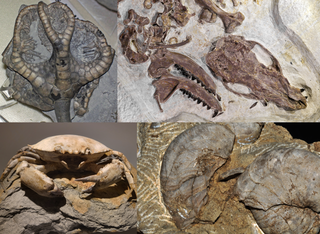
A fossil is any preserved remains, impression, or trace of any once-living thing from a past geological age. Examples include bones, shells, exoskeletons, stone imprints of animals or microbes, objects preserved in amber, hair, petrified wood and DNA remnants. The totality of fossils is known as the fossil record.
The PaleozoicEra is the first of three geological eras of the Phanerozoic Eon. Beginning 538.8 million years ago (Ma), it succeeds the Neoproterozoic and ends 251.9 Ma at the start of the Mesozoic Era. The Paleozoic is subdivided into six geologic periods :

Deep-sea fish are fish that live in the darkness below the sunlit surface waters, that is below the epipelagic or photic zone of the sea. The lanternfish is, by far, the most common deep-sea fish. Other deep-sea fishes include the flashlight fish, cookiecutter shark, bristlemouths, anglerfish, viperfish, and some species of eelpout.
Monte Bolca is a lagerstätte near Verona, Italy that was one of the first fossil sites with high quality preservation known to Europeans, and is still an important source of fossils from the Eocene.
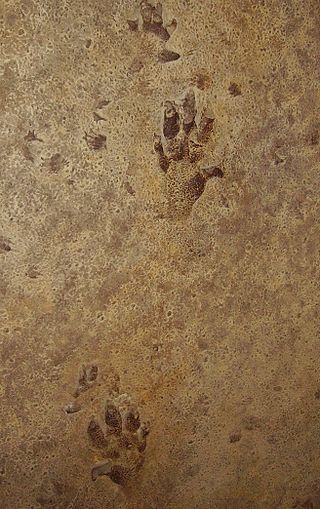
A trace fossil, also known as an ichnofossil, is a fossil record of biological activity by lifeforms but not the preserved remains of the organism itself. Trace fossils contrast with body fossils, which are the fossilized remains of parts of organisms' bodies, usually altered by later chemical activity or mineralization. The study of such trace fossils is ichnology and is the work of ichnologists.

An otolith, also called statoconium or otoconium or statolith, is a calcium carbonate structure in the saccule or utricle of the inner ear, specifically in the vestibular system of vertebrates. The saccule and utricle, in turn, together make the otolith organs. These organs are what allows an organism, including humans, to perceive linear acceleration, both horizontally and vertically (gravity). They have been identified in both extinct and extant vertebrates.

Macrofossils, also known as megafossils, are the preserved remnants of organic beings and their activities that are large enough to be visible without a microscope. The term macrofossil stands in opposition to the term microfossil. Microfossils, by contrast, require substantial magnification for evaluation by fossil-hunters or professional paleontologists. As a result, most fossils observed in the field and most specimens are macrofossils. Macrofossils come in many varieties and form in various ways depending on their environment and what is being fossilized including plant, fungi and animal remnants.

Tiktaalik is a monospecific genus of extinct sarcopterygian from the Late Devonian Period, about 375 Mya, having many features akin to those of tetrapods. Tiktaalik is estimated to have had a total length of 1.25–2.75 metres (4.1–9.0 ft) based on various specimens.
Trace fossils are classified in various ways for different purposes. Traces can be classified taxonomically, ethologically, and toponomically, that is, according to their relationship to the surrounding sedimentary layers. Except in the rare cases where the original maker of a trace fossil can be identified with confidence, phylogenetic classification of trace fossils is an unreasonable proposition.
Undichna is a fish-fin, or fish-swimming fossil trail left as a fossil impression on a substrate, or the opposite impression on an overlying substrate; this type of fossil is an ichnofossil, in this case a specific ichnogenus, Undichna; the term "undichna" is composed of the words: 'und'–'ichna', for "wave-trace".
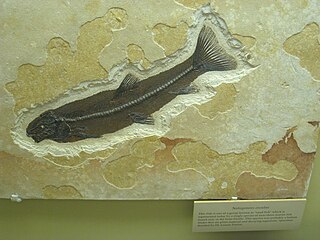
Notogoneus is an extinct genus of prehistoric ray-finned fish. A trace fossil attributed to Notogoneus osculus has been found in the Green River Formation.
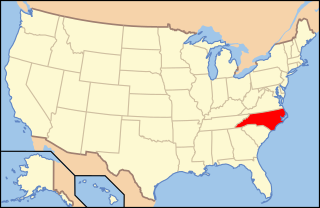
Paleontology in North Carolina refers to paleontological research occurring within or conducted by people from the U. S. state of North Carolina. Fossils are common in North Carolina. According to author Rufus Johnson, "almost every major river and creek east of Interstate 95 has exposures where fossils can be found". The fossil record of North Carolina spans from Eocambrian remains that are 600 million years old, to the Pleistocene 10,000 years ago.

Paleontology in Wyoming includes research into the prehistoric life of the U.S. state of Wyoming as well as investigations conducted by Wyomingite researchers and institutions into ancient life occurring elsewhere.

Paleontology in Colorado refers to paleontological research occurring within or conducted by people from the U.S. state of Colorado. The geologic column of Colorado spans about one third of Earth's history. Fossils can be found almost everywhere in the state but are not evenly distributed among all the ages of the state's rocks. During the early Paleozoic, Colorado was covered by a warm shallow sea that would come to be home to creatures like brachiopods, conodonts, ostracoderms, sharks and trilobites. This sea withdrew from the state between the Silurian and early Devonian leaving a gap in the local rock record. It returned during the Carboniferous. Areas of the state not submerged were richly vegetated and inhabited by amphibians that left behind footprints that would later fossilize. During the Permian, the sea withdrew and alluvial fans and sand dunes spread across the state. Many trace fossils are known from these deposits.

Paleontology in New Mexico refers to paleontological research occurring within or conducted by people from the U.S. state of New Mexico. The fossil record of New Mexico is exceptionally complete and spans almost the entire stratigraphic column. More than 3,300 different kinds of fossil organisms have been found in the state. Of these more than 700 of these were new to science and more than 100 of those were type species for new genera. During the early Paleozoic, southern and western New Mexico were submerged by a warm shallow sea that would come to be home to creatures including brachiopods, bryozoans, cartilaginous fishes, corals, graptolites, nautiloids, placoderms, and trilobites. During the Ordovician the state was home to algal reefs up to 300 feet high. During the Carboniferous, a richly vegetated island chain emerged from the local sea. Coral reefs formed in the state's seas while terrestrial regions of the state dried and were home to sand dunes. Local wildlife included Edaphosaurus, Ophiacodon, and Sphenacodon.

Indian Springs Trace Fossil Natural Area is a 40-acre privately owned site on the Indian Springs Ranch in Fremont County, Colorado. It was designated a National Natural Landmark in 1980.
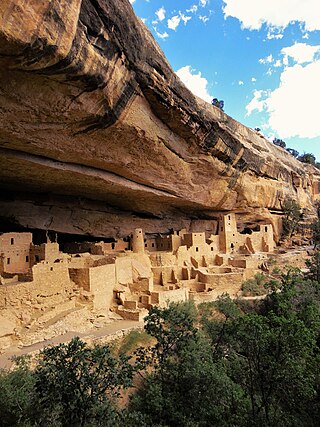
The Cliff House Sandstone is a late Campanian stratigraphic unit comprising sandstones in the western United States.

Burrow fossils are the remains of burrows - holes or tunnels excavated into the ground or seafloor - by animals to create a space suitable for habitation, temporary refuge, or as a byproduct of locomotion preserved in the rock record. Because burrow fossils represent the preserved byproducts of behavior rather than physical remains, they are considered a kind of trace fossil. One common kind of burrow fossil is known as Skolithos, and the similar Trypanites, Ophiomorpha and Diplocraterion.

The Bokkeveld Group is the second of the three main subdivisions of the Cape Supergroup in South Africa. It overlies the Table Mountain Group and underlies the Witteberg Group. The Bokkeveld Group rocks are considered to range between Lower Devonian (Lochkovian) to Middle Devonian (Givetian) in age.

The Middleton Formation is a geological formation that extends through the Northern Cape, Western Cape, and Eastern Cape provinces of South Africa. It overlies the lower Abrahamskraal Formation, and is the eastern correlate, East of 24ºE, of the Teekloof Formation. Outcrops and exposures of the Middleton Formation range from Graaff-Reinet in the Eastern Cape onwards. The Middleton Formation's type locality lies near the small hamlet, Middleton, approximately 25 km south of Cookhouse. Other exposures lie in hillsides along the Great Fish River in the Eastern Cape. The Middleton Formation forms part of the Adelaide Subgroup of the Beaufort Group, which itself forms part of the Karoo Supergroup.
References
- ↑ Gregory, Murray (17 Dec 2008). "New trace fossils from the Miocene of Northland, New Zealand: Rorschachichnus amoeba and Piscichnus waitemata". Ichnos. 1 (3): 195–205. doi:10.1080/10420949109386352.